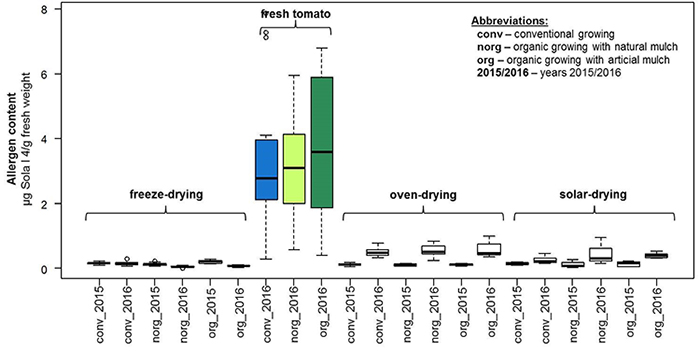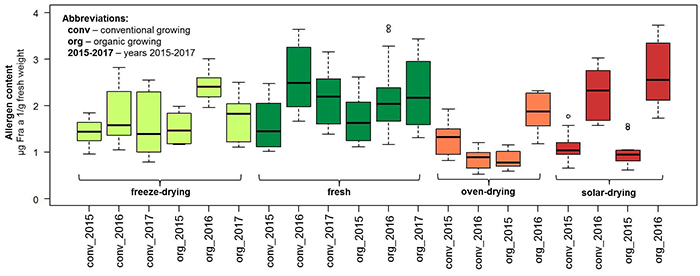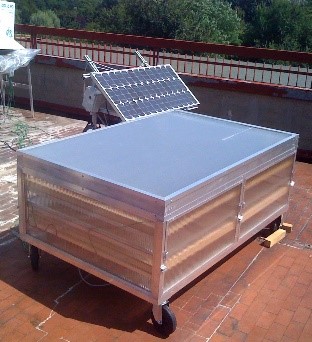Allergens in tomatoes, strawberries and apples: Influence of production systems and processing methods
Food allergies are an increasing health problem. The project “FaVOR-DeNonDe” studies the effects of different cultivation methods and processing techniques on the allergen content in fruits and vegetables.

The project “FaVOR-DeNonDe” analyses the influence of organic and conventional farming and different processing techniques on the levels of desired and non-desired compounds in food products.
The effects on the allergen content in apples, strawberries and tomatoes, as well as processed food products (dried fruits, apple juice and strawberry jam) are presented, based on the enzyme-linked immunosorbent assay (ELISA).
Food allergy and pathogenesis-related (PR) proteins
Food allergies are an increasing health problem, affecting 3-4 % of the adult population and 5 % of children. Plant allergens are a major source of allergenic reactions. Due to the local distribution of pollen, birch pollen allergies are common in Northern Europe and are evoked by the major birch pollen allergen Bet v 1. Cross-reactivity affects 90 % of patients who are allergic to birch pollen and develop intolerances to various fruits and vegetables. Similar protein structures of Bet v 1 and homologous proteins present in fruits and vegetables lead to cross-reacting antibodies and consequently to allergic reactions.
The family 10 of pathogenesis-related proteins (PR-10), including Bet v 1 and Bet v 1-homologous proteins, are plant proteins induced by various stress conditions, e.g. pathogen attack, wounds or environmental factors. Therefore, it was assumed that cultivation conditions would affect allergen levels. Furthermore the amount of allergens might be dependent on cultivar and storage conditions.
Drying tomatoes reduces the Sola l 4 allergen content
Sola l 4 is the Bet v 1-homologous allergen found in tomato fruits. Cultivar Perbruzzo was grown either conventionally (conv) or with two types of organic growing methods in Italy in 2015 and 2016. For organic growing either artificial mulch (org) or natural mulch (norg) was used. Furthermore, ripe fruits were dried using different methods (oven-, solar-, freeze-drying). The Sola l 4 allergen content decreased significantly with thermal treatment, when considering the allergen content of dried fruits relative to the respective fresh weight (Figure 1). PR-10 proteins are heat-sensitive and denature during processing.

Figure 1: Sola l 4 allergen content in µg/g fresh weight of tomato cultivar Perburzzo. Plants were grown either conventionally (conv) or with two types of organic growing methods (org, norg) in 2015 and 2016. Fruits were dried with different methods (freeze-, oven- and solar-drying).
As stress factors, including biotic factors such as fungal, viral and bacterial pathogens, induce the synthesis of pathogenesis-related proteins, it was assumed that organically grown tomatoes would produce higher levels of the Sola l 4 protein. However this was not the case, as the differences between organically and conventionally grown tomatoes were not significant. Varying weather conditions from year to year seems to have a more important effect on the allergen content.
Moreover, the Sola l 4 content is cultivar-dependent. Among 23 different varieties, the allergen amount varies between 0.24 and 1.71 µg Sola l 4/g fresh weight.
Fra a 1 content in raw and dried strawberry fruits
Strawberries are consumed worldwide as fresh fruits or processed products (jam, yoghurt). Fra a 1 is the Bet v 1-homologous allergen found in strawberry fruits. Fragaria × ananassa cultivar Asia was grown either conventionally or organically in Italy between 2015 and 2017. Ripe fruits were dried using different methods (oven-, solar-, freeze-drying) and used for jam production. The Fra a 1 allergen is more stable against thermal processing compared to the heat-labile tomato allergen Sola l 4. The amount of allergen in fresh and dried strawberries was similar (Figure 2). Drying of strawberries, especially in the oven, slightly decreased the Fra a 1 content, whereas freeze-drying did not change the allergen amount significantly. Differences between the two growing methods (organic versus conventional) were not observed. Changing weather conditions from year to year seems to have a more significant effect on the Fra a 1 allergen level.

Figure 2: Fra a 1 allergen content in µg/g fresh weight of strawberry fruits cultivar Asia. Plants were grown either conventionally (conv) or organically (org) from 2015-2017. Fruits were dried with different methods (freeze-, oven- and solar-drying).
Pasteurization reduces allergen content of apple juice
Mal d 1 is the major allergen from apples. Apple juice from different cultivars grown conventionally or organically were pressed with either a water press, a rack-and-frame-press or a belt-press. In conclusion, pasteurized apple juice contains lower Mal d 1 allergen content than unpasteurized apple juice, due to the heat-lability of the apple allergen. However, differences between pressing methods were not significant.
Conclusion
Bet v 1-homologous proteins were extracted from raw and processed food material and the allergen content was quantified using an indirect competitive ELISA. The Sola l 4 allergen from tomatoes and the Fra a 1 allergen from strawberry fruits displayed different thermal stability. In the dried tomatoes, the allergen content was significantly lower compared to fresh fruits, in contrast to dried strawberries, where the Fra a 1 content of fresh and processed fruits was similar.
Cultivation methods showed no significant effect on the allergen content. However, seasonal effects, including temperature, rainfall, humidity and pathogens, influence the allergen amount to a greater extent.
In addition to the ELISA, conducting skin prick tests and basophil activation tests on allergic patients would further indicate whether patients could really tolerate specific food products.

Solar-dryer wins Innovation prize
The apparatus won the Bronze Medal for Innovation and Sustainability in Food Processing at the MACFRUT 2017, held in Cesena (Italy) It has also been used in the FAVORDENONDE project, to sustainably dry organic fruits and vegetables. (Roberto Lo Scalzo) |
|---|